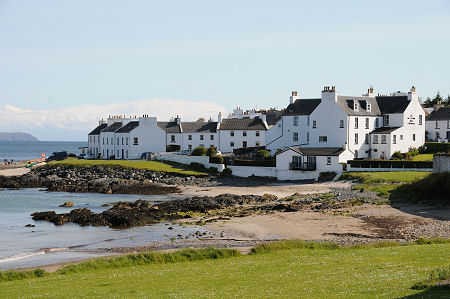The two types of what are considered to be blends, in the whisky world, are a) blended malt scotch, a.k.a. vatted malt, and b) blended scotch. These terms and their definitions are set by the Scotch Whisky Association in Scotland.
A blended, or vatted, malt is a blend of multiple single malt whiskies from different distilleries, such as 'Big Peat', which is very good, produced by Douglas Llaing (an independent bottler). For example, if a bottler was to sell a whisky which contained 50% Ardbeg single malt, and 50% Glenfiddich single malt, it would be considered a blended, or vatted, malt scotch. These vatted malts can be great value, and are usually of good quality.
A blended scotch whisky, on the other hand, contains both single malt whisky, and single grain whisky. For example, a bottle of Johnnie Walker red label (yuck!) contains a set amount of malt whisky (from different sources), and the remainder is grain whisky. For obvious reasons this type is, generally, considerably cheaper than a blended malt whisky. These whiskies are generally not as complex or 'interesting' as a single malt, and are usually chill-filtered and artificially-coloured.
For the moment, we will focus on blended scotch whisky, as this is what I'm review today, with the Johnnie Walker Double Black. Interestingly, all currently available Johnnie Walker whiskies are blended scotch, containing grain whisky. Yes, even the ridiculously over-priced and over-hyped 'blue label' contains some (cheaper) grain whisky, although the exact proportions and sources are a closely guarded secret. There was a vatted malt Johnnie Walker, the Green Label, which sadly is now discontinued. It was, and still is, the best Johnnie Walker I've tasted. It even has/had the whisky sources listed on the box! If you come across a bottle of the green label, grab it.
The JW double black is, as you can guess, based on the standard black label, which is good value for it's price, with surprising complexity. The double black is marketed as having "a rich, intense, smokier flavour". It certainly is smokier than the black label, probably due to some extra Caol Ila and/or Talisker being added to the blend.
Johnnie Walker 'Double Black' blended whisky, 40%, Scotland.
NAS, chill filtered, artificial colouring added. Number or source of component spirits not stated.
(tasted neat and with a tiny drop of water)
Colour: Copper (thanks to the added caramel colouring, no doubt)
Nose: Honey and caramel, some malted cereals, something a little acidic, like under-ripe grapes. A hint of smoke, but certainly not intense.
Texture: Thin, clean.
Taste: Big honey sweetness, some (talisker/caol ila) smoke but it fades quickly. Reminds me of a thinner Highland Park 12yo with a bit of extra smoke. Only a tiny bit of peat detectable, sadly. Found a strange bitter 'off' note in the middle which I found a bit off-putting.
Finish: Short, that weird bitter note is still there, and a bit of heat on the tongue (surprising for only 40%), fades to a honey sweetness.
Score: 2 out of 5 (blend score).
Notes: I had high hopes for this one, being based on the standard black label, but it has let me down. It's not overly unpleasant, especially for the relatively low price, but it just doesn't do anything for me. The complexity of the black label has been lost, I wonder if the double uses younger stock? A little disappointing, and not worth the extra over the standard black, which I prefer to this. It would make for some interesting mixed drinks or cocktails though, with that added smoke. If you'd like to try it, I'd suggest looking for it in a bar first rather than buying a bottle.
I don't want to seem anti-blend, there are a massive amount of blends on the market, and I'm sure at least some are quite good! For a decent (and cheap) peaty/smoky blended whisky, head for 'Black Bottle', produced by Burn Stewart, but preferably in the older style pictured below. Look for a review shortly!
Cheers.











